

|

|
|||

|

|
||
|
"Methuselah" Palm Grown From 2,000-Year-Old Seed Is a Father
A male date palm tree named Methuselah that sprouted from a 2,000-year-old seed nearly a decade ago is thriving today. He is over three meters [ten feet] tall, he's got a few offshoots, he has flowers, and his pollen is good. He pollinated a female with his pollen, a wild [modern] female and he can make dates. excerpt and photo from: http://news.nationalgeographic.com/2015/03/150324-ancient-methuselah-date-palm-sprout-science/?utm_source=Twitter&utm_medium=Social&utm_content=link_tw20150325news-methuselah&utm_campaign=Content&sf8196228=1 Send this link to anyone you think would be interested in reading this entry. |

|
|||

|

|
||
|
The Kepler Mission: NASA's first mission capable of finding Earth-size planets around other stars.
The centuries-old quest for other worlds like our Earth has been rejuvenated by the intense excitement and popular interest surrounding the discovery of hundreds of planets orbiting other stars. There is now clear evidence for substantial numbers of three types of exoplanets; gas giants, hot-super-Earths in short period orbits, and ice giants. The challenge now is to find terrestrial planets (i.e., those one half to twice the size of the Earth), especially those in the habitable zone of their stars where liquid water and possibly life might exist. The Kepler Mission, NASA Discovery mission #10, is specifically designed to survey a portion of our region of the Milky Way galaxy to discover dozens of Earth-size planets in or near the habitable zone and determine how many of the billions of stars in our galaxy have such planets. Results from this mission will allow us to place our solar system within the continuum of planetary systems in the Galaxy. Kepler is a space observatory launched by NASA to discover Earth-like planets orbiting other stars. The spacecraft, named after the Renaissance astronomer Johannes Kepler, was launched on March 7, 2009 As of January 2015, Kepler and its follow-up observations had found 1,013 confirmed exoplanets in about 440 stellar systems, along with a further 3,199 unconfirmed planet candidates. Four planets have been confirmed through Kepler?'?s K2 mission. In November 2013, astronomers reported, based on Kepler space mission data, that there could be as many as 40 billion Earth-sized planets orbiting in the habitable zones of Sun-like and red dwarf stars within the Milky Way. It is estimated that 11 billion of these planets may be orbiting Sun-like stars. The image is the Kepler Spacecraft and Photometer http://kepler.nasa.gov/Mission/QuickGuide/ http://en.wikipedia.org/wiki/Kepler_%28spacecraft%29 Send this link to anyone you think would be interested in reading this entry. |

|
|||

|

|
||
|
Happy Birthday Eeyore!
Well, actually I am a day late with this greeting. And with Eeyore's outlook, he would probably say, "What a nice greeting, even if it is a day late." Eeyore has a penchant for gloomy ruminations. But his particular outlook on life produces some pretty great (and perfectly deadpan) witticisms. Eeyore has a clever, brilliant, sense of straight-faced humor that he can expertly pull off, with or without his tail. A well-known Eeyore quote: "It's snowing still," said Eeyore gloomily. "So it is." "And freezing." "Is it?" "Yes," said Eeyore. "However," he said, brightening up a little, "we haven't had an earthquake lately." Here is the source of the great image of our favorite positive/negative character: ~ http://blogs.disney.com/oh-my-disney/2013/09/17/12-amazing-witticisms-from-eeyore/ ~ quote from: http://www.winnie-pooh.org/eeyore-quotes.htm Send this link to anyone you think would be interested in reading this entry. |

|
|||

|

|
||
|
Diving into the Dark Web: Where does your stolen data go?
When a data breach occurs and personal information is stolen, where does it end up? Bitglass researchers decided to find out. Target, Morgan Stanley, Sony, Anthem - the list of today's major data breaches goes on. In the last few years alone, high-profile attacks have been launched against these companies and countless others, resulting in the theft of private communication, names, Social Security numbers, addresses, financial data and account credentials. According to a report released by the Identity Theft Resource Center (ITRC), in the United States alone in 2014, 783 data breaches were discovered. Since 2005, 5,029 data breaches have been reported in the US, with an estimated 675 million records stolen. The Dark Web is one place where stolen information is offered for sale. Accessible through the Tor network, the underground comprises of stores and websites entrenched in illegal activities ranging from the sale of data to hacking tools to drugs and weaponry. However, websites hosted on the network also offer free downloads of data, which is posted anonymously. The security team decided to track data offered up in the Dark Web. After creating a spreadsheet of 1,568 fake employee credentials, the team placed the file on anonymous file-sharing websites in the Dark Web, as well as Dropbox. The data was then tracked through Bitglass' tracking technology, which embedded the file with an invisible watermark that "pings" the Bitglass portal whenever the document is opened. After being pinged, the portal displays information including geographic location, IP address and device type. Bitglass found that within only a few days, the fake credentials had been downloaded in over five countries, three continents and was viewed over 200 times. By day 12, the file had received over 1,080 clicks and had spread to 22 countries on five continents. By the end of the experiment the fake document of employee data had made its way to North America, South America, Asia, Europe, and Africa. Countries frequently associated with cyber criminal activity, including Russia, China and Brazil, were the most common access points for the identity data. Security breaches are unavoidable. It can take months or even years for the enterprise to discover a security problem. By this point, stolen information may have already traveled worldwide. When so many data breaches are preventable, companies need to start investing more heavily not only in cybersecurity as a whole, but also begin tightening internal controls and data protection protocols to mitigate the risk of becoming a new victim in 2015. ~image and excerpt from: http://www.zdnet.com/article/diving-into-the-dark-web-where-does-your-stolen-data-go-in-the-underground/?tag=nl.e019&s_cid=e019&ttag=e019&ftag=TREd47db54 Resource: http://www.zebis.com/business.html Send this link to anyone you think would be interested in reading this entry. |

|
|||

|

|
||
|
Red Colobus Monkey
A recent photo of Red Colobus Monkey have proven that they are not extinct. A recent photograph of the red colobus monkey has been captured by two primatologists working in the forests of the Republic of Congo. The red colobus monkey is a rare primate and was not spotted in the wild after 1970s. Since it has not been seen for such a long time, people started believing that it went extinct. However, the team found a group of red colobus in the swamp forests along the Bokiba River in the national park. The feat was made possible with the help of local people familiar with red colombus vocalizations and behavior. Red colobuses are primarily arboreal and are highly sensitive to hunting and habitat destruction, and have been referred to as probably the most threatened taxonomic group of primates in Africa. ~image and excerpt from: http://www.dispatchtimes.com/a-recent-photo-of-red-colobus-monkey-have-proven-that-they-are-not-extinct/2486/ ~excerpt from: http://en.wikipedia.org/wiki/Red_colobus Send this link to anyone you think would be interested in reading this entry. |

|
|||

|

|
||
|
Earth Day
The first Earth Day on April 22, 1970, activated 20 million Americans from all walks of life and is widely credited with launching the modern environmental movement. Each year, Earth Day - April 22 - marks the anniversary of what many consider the birth of the modern environmental movement in 1970. The height of hippie and flower-child culture in the United States, 1970 brought the death of Jimi Hendrix, the last Beatles album, and Simon & Garfunkel's "Bridge Over Troubled Water". Protest was the order of the day, but saving the planet was not the cause. War raged in Vietnam, and students nationwide increasingly opposed it. The idea came to Earth Day founder Gaylord Nelson, then a U.S. Senator from Wisconsin, after witnessing the ravages of the 1969 massive oil spill in Santa Barbara, California. Inspired by the student anti-war movement, he realized that if he could infuse that energy with an emerging public consciousness about air and water pollution, it would force environmental protection onto the national political agenda. Senator Nelson announced the idea for a "national teach-in on the environment" to the national media; persuaded Pete McCloskey, a conservation-minded Republican Congressman, to serve as his co-chair; and recruited Denis Hayes as national coordinator. Hayes built a national staff of 85 to promote events across the land. Image from: http://mashable.com/category/earth-day/ ~excerpt from: http://www.earthday.org/about-earth-day-network-3 Send this link to anyone you think would be interested in reading this entry. |

|
|||

|
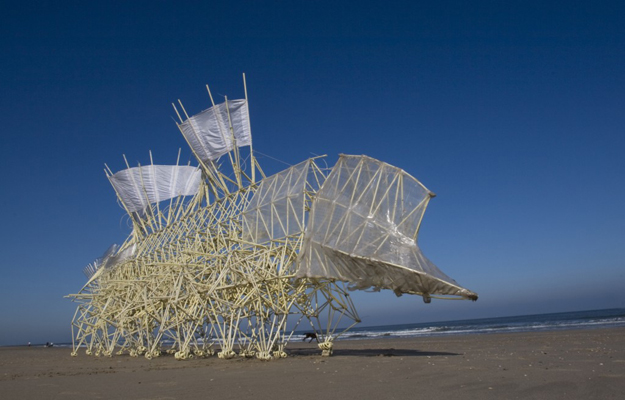
|
||
|
Theo Jansen
"Since 1990 I have been occupied creating new forms of life. Not pollen or seeds but plastic yellow tubes are used as the basic material of this new nature. I made skeletons that are able to walk on the wind, so they don't have to eat. Over time, these skeletons have become increasingly better at surviving the elements such as storm and water and eventually I want to put these animals out in herds on the beaches, so they will live their own lives." Self-propelling beach animals like Animaris Percipiere have a stomach . This consists of recycled plastic bottles containing air that can be pumped up to a high pressure by the wind. This is done using a variety of bicycle pump, needless to say of plastic tubing. Several of these little pumps are driven by wings up at the front of the animal that flap in the breeze. It takes a few hours, but then the bottles are full. They contain a supply of potential wind. Take off the cap and the wind will emerge from the bottle at high speed. The trick is to get that untamed wind under control and use it to move the animal. For this, muscles are required. Beach animals have pushing muscles which get longer when told to do so. These consist of a tube containing another that is able to move in and out. There is a rubber ring on the end of the inner tube so that this acts as a piston. When the air runs from the bottles through a small pipe in the tube it pushes the piston outwards and the muscle lengthens. The beach animal's muscle can best be likened to a bone that gets longer. Muscles can open taps to activate other muscles that open other taps, and so on. This creates control centres that can be compared to brains. ~ This excerpt is only a very small part of some amazing info on this work. Please take a look at the site and watch these creations in action. http://www.strandbeest.com/ Send this link to anyone you think would be interested in reading this entry. |

|
|||

|

|
||
|
Twinkle Twinkle All Stars
Stars twinkle. Planets shine steadily. Why? Stars twinkle (scintillate) because they're so far away from Earth that, even through large telescopes, they appear only as pinpoints. And it's easy for Earth's atmosphere to disturb the pinpoint light of a star. Thus the stars twinkle. As a star's light pierces our atmosphere, each single stream of starlight is forced by the atmosphere to zig and zag this way and that. And so stars appear to twinkle. On the other hand, planets don't twinkle (usually) simply because they're closer to Earth. You'd know they're closer if you looked through a telescope. Through telescopes, planets don't look like pinpoints. Instead, they look like tiny disks. And while the light from one edge of a planet's disk might be forced to "zig" by Earth's atmosphere, light from the opposite edge of the disk might "zag" in an opposite way. The zigs and zags cancel each other out and that's why planets appear to shine steadily. By the way, if you could see stars and planets from outer space, both would shine steadily. There'd be no atmosphere to disturb the steady streaming of their light. ~excerpt from: http://earthsky.org/space/why-dont-planets-twinkle-as-stars-do Send this link to anyone you think would be interested in reading this entry. |

|
|||

|

|
||
|
Haiku
Haiku is one of the most important forms of traditional Japanese poetry. Haiku is, today, a 17-syllable verse form consisting of three metrical units of 5, 7, and 5 syllables. Haiku poems date from 9th century Japan to the present day. Haiku is more than a type of poem; it is a way of looking at the physical world and seeing something deeper, like the very nature of existence. Traditional haiku often focuses on very simple subjects while providing an interesting or unexpected perspective. Two distinct images are usually placed in juxtaposition, allowing the reader to see an enlightening connection between the two. Haiku often contains a seasonal reference and poems are traditionally about nature or the natural world. One famous haiku: My life, - How much more of it remains? The night is brief. - Shiki ~excerpts from: http://examples.yourdictionary.com/examples-of-haiku-poems.html http://www.haiku-poetry.org/famous-haiku.html Send this link to anyone you think would be interested in reading this entry. |

|
|||

|

|
||
|
Save the Elephant Day (4/16)
Once common throughout Africa and Asia, elephant numbers were severely depleted during the 20th century, largely due to the massive ivory trade. While some populations are now stable and growing, poaching, conflict and habitat destruction continue to threaten the species. The largest land mammal on earth, the African elephant weighs up to eight tons. The elephant is distinguished by its massive body, large ears and a long trunk, which has many uses ranging from using it as a hand to pick up objects, as a horn to trumpet warnings, an arm raised in greeting to a hose for drinking water or bathing. Elephants are of the family Elephantidae and the order Proboscidea. Two species are traditionally recognized, the African elephant and the Asian elephant, although some evidence suggests that African bush elephants and African forest elephants are separate species. Elephants are scattered throughout sub-Saharan Africa, South Asia, and Southeast Asia. Elephants are herbivorous and can be found in different habitats including savannahs, forests, deserts and marshes. They prefer to stay near water. They are considered to be keystone species due to their impact on their environments. Other animals tend to keep their distance, predators such as lions, tigers, hyenas and wild dogs usually target only the young elephants (or "calves"). Females ("cows") tend to live in family groups, which can consist of one female with her calves or several related females with offspring. African elephants are listed as vulnerable by the International Union for Conservation of Nature (IUCN), while the Asian elephant is classed as endangered. ~excerpts from: http://en.wikipedia.org/wiki/Elephant https://www.worldwildlife.org/species/elephant original photo by dmdart Send this link to anyone you think would be interested in reading this entry. |

|
|||

|

|
||
|
Taliesin West
Taliesin West is a national historic landmark nestled in the desert foothills of the McDowell Mountains outside of Scottsdale, AZ. It is also the home of the Frank Lloyd Wright Foundation and Taliesin, The Frank Lloyd Wright School of Architecture. Wright's beloved winter home and the bustling headquarters of the Taliesin Fellowship, Taliesin West was established in 1937 and diligently handcrafted over many years into a utopian world unto itself. Deeply connected to the desert from which it was forged, Taliesin West possesses an almost prehistoric grandeur. It was built and maintained almost entirely by Wright and his apprentices, making it among the most personal of the architect's creations. Wright and the Taliesin Fellowship began to "trek" to Arizona each winter in 1933. In 1937 Wright purchased the plot of desert land that would soon become Taliesin West. He paid $3.50 an acre on a southern slope of the McDowell Range overlooking Paradise Valley outside Scottsdale. Wright believed this to be the perfect spot for such a building: a place of residence, a place of business and a place to learn. Wright described it like this, "Finally I learned of a site twenty-six miles from Phoenix, across the desert of the vast Paradise Valley. On up to a great mesa in the mountains. On the mesa just below McDowell Peak we stopped, turned, and looked around. The top of the world. The view at Taliesin West was critical to its success. In the 1940s Wright waged a battle against overhead power lines on aesthetic grounds. In the late 1940s when power lines appeared within the view of Taliesin West, Wright wrote President Harry S. Truman, demanding they be buried. It was a losing battle. So after briefly considering rebuilding in Tucson, he "turned his back on the valley," moving the entrance to the rear of the main building. ~image and excerpts from: http://en.wikipedia.org/wiki/Taliesin_West http://www.franklloydwright.org/taliesin-west/plan-a-visit.html Send this link to anyone you think would be interested in reading this entry. |

|
|||

|

|
||
|
Napier Jewelry of a Past Age
Marilyn Monroe wore Napier when she posed for the cover of Movieland magazine in 1954. That same decade, Mamie Eisenhower, Arlene Francis, Miss America, and the Duchess of Windsor all flaunted Napier. Doris Day even endorsed two namesake lines from Napier. The brand was often on the cutting edge of jewelry fashion. It was one of the first companies to bring jewelry designs directly from Paris. During its Golden Age in the 1950s, Napier put out everything from a subdued line of "tailored" jewelry to countless numbers of bombastic pieces that might be modernist abstractions, mid-century kitsch, or explosions of Rococo frippery. "We always maintain that Napier was not a costume jewelry manufacturer," says Meoni, who was the president of Napier between 1985 and 1995. "Napier was a fashion jewelry manufacturer because we were making a high-quality product on the high-end of the market. We catered to the upper-level department stores such as Bergdorf Goodman and Gump's." There's more to read at: http://www.collectorsweekly.com/articles/are-you-bold-and-brassy-enough-to-wear-vintage-napier-jewelry/ Send this link to anyone you think would be interested in reading this entry. |

|
|||

|
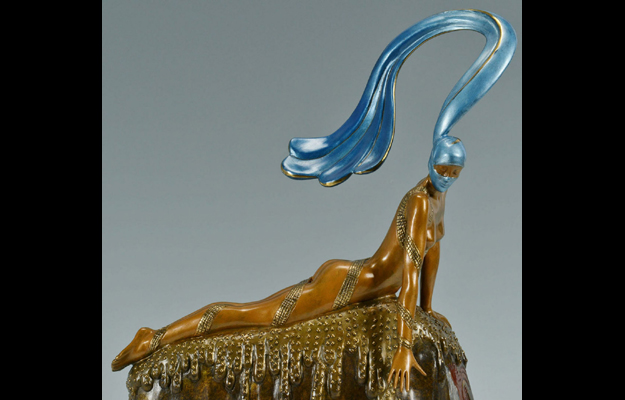
|
||
|
Erte
Erte was born Romain de Tirtoff in St. Petersburg, Russia. The only son of an admiral in the Imperial Fleet, he was raised amidst Russia's social elite. As a young boy, he was fascinated by the Persian miniatures he found in his father's library. These exotic, brightly patterned designs continued to be important to him and influenced the development of his style. He moved to Paris at the age of eighteen and took the name Erte, from the French pronunciation of his initials, R and T. He was a diversely talented 20th-century artist and designer who flourished in an array of fields, including fashion, jewellery, graphic arts, costume and set design for film, theatre, and opera, and interior decor. Erte is perhaps most famous for his elegant fashion designs which capture the art deco period in which he worked. One of his earliest successes was designing apparel for the French dancer Gaby Deslys who died in 1920. His delicate figures and sophisticated, glamorous designs are instantly recognizable, and his ideas and art still influence fashion into the 21st century. His costumes, programme designs, and sets were featured in the Ziegfeld Follies of 1923, many productions of the Folies Bergere, and George White's Scandals. On Broadway, the celebrated French chanteuse Irene Bordoni wore Erte's designs. At the age of 75, Erte was encouraged to embark on a new career and began to recreate the remarkable designs of his youth in bronze and serigraphy. The Art Deco movement was hence reborn. A lifetime of international success and recognition has ensured this unique artist's place in the annals of art history, and his original designs grace the permanent collections of prestigious museums throughout the world including New York's Metropolitan Museum of Art, Museum of Modern Art, the Smithsonian Institution and London's Victoria & Albert Museum. ~image and excerpts from: http://rogallery.com/Erte/erte-biography.htm http://en.wikipedia.org/wiki/Ert%C3%A9 Send this link to anyone you think would be interested in reading this entry. |

|
|||

|
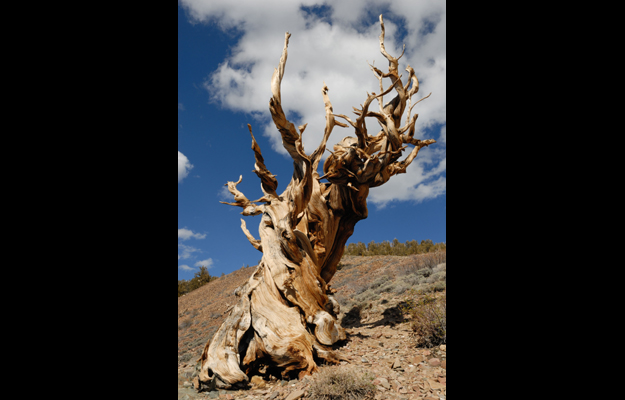
|
||
|
The Oldest Tree: The Prometheus Tree
In 1964, a geologist in the Nevada wilderness discovered the oldest living thing on earth, after he killed it. The young man was Donald Rusk Currey, a graduate student studying ice-age glaciology in Eastern Nevada; the tree he cut down was of the Pinus longaeva species, also known as the Great Basin bristlecone pine. Working on a grant from the National Science Foundation, Currey was compiling the ages of ancient bristlecone trees to develop a glacial timeline for the region. Currey's ring count for this particular tree reached backward from the present, past the founding of the United States, the Great Crusades, and even the Greek and Roman Empires, to the time of the ancient Egyptians. Sheltered in an unremarkable grove near Wheeler Peak, the bristlecone he cut down was found to be nearly 5,000 years old, taking root only a few hundred years after human history was first recorded. The Prometheus tree's felling made it doubly symbolic, as the myth of its namesake captures both the human hunger for knowledge and the unintended negative consequences that often result from this desire. Though members of the scientific community and press were outraged that the tree was killed, Currey's mistake ultimately provided the impetus to establish Great Basin National Park to protect the bristlecones. The death of the Prometheus tree also helped to change our larger perception of trees as an infinitely replenishing resource. At the time, it was just a tree, and the mindset was that trees were a renewable resource and they would grow back. And it didn't seem like it was any particularly special tree. To this day, Prometheus still holds the count for the most rings of any tree, at 4,862. ~excerpt from: http://www.collectorsweekly.com/articles/oldest-living-tree-tells-all/ Send this link to anyone you think would be interested in reading this entry. |

|
|||

|
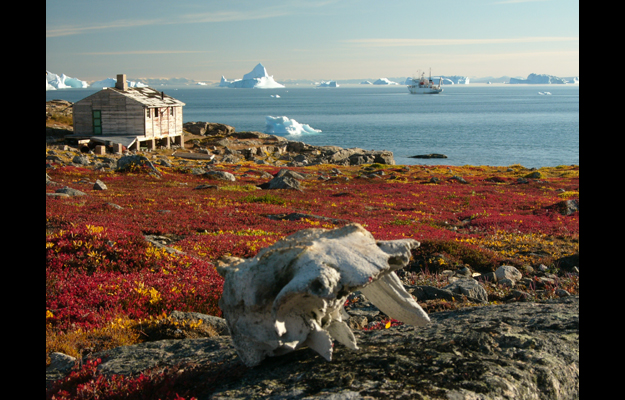
|
||
|
Tundra
The Arctic Tundra is the world's youngest biome. It was formed 10,000 years ago. The tundra is a vast and treeless land which covers about 20% of the Earth's surface, circumnavigating the North pole. It is usually very cold, and the land is pretty stark. The Arctic tundra is also a windy place and winds can blow between 30 to 60 miles per hour. Tundra comes from the Finnish word "tunturia", which means a barren land. The ground is permanently frozen 10 inches to 3 feet down so that trees can't grow. The bare and sometimes rocky ground can only support low growing plants like mosses, heaths, and lichen. In the winter it is cold and dark and in the summer, when the snow and the top layer of permafrost melt, it is very soggy and the tundra is covered with marshes, lakes, bogs and streams that breed thousands of insects and attract many migrating birds. The tundra is a very fragile environment. The extremely cold temperatures makes it a difficult environment to survive in during the winter, and plants and animals have a hard time coping with any extra stresses and disturbances. More people moving to the tundra to work in the mines and oil rigs have created towns and more roads. Some animal's movements to traditional feeding and denning grounds have been disrupted by these obstacles. When they try to pass through a town they are often scared away or shot. With their feeding patterns disrupted, many polar bears have starved. The Alaskan oil pipeline was built across a caribou migration route. In some places the pipeline has been raised above the ground so the caribou can pass under it. Pesticides have been used to control the hordes of insects. Thousands of migrating birds come to the tundra because of the abundant insects. Through the food chain the pesticides reach many of the animals that live on the tundra. Pollution from mining and drilling for oil has polluted the air, lakes and rivers. The land around some nickel mines in Russia has become so polluted that the plants in the surrounding area have died. Footprints and tire tracks can be visible for many years after they were made. When the sun hits the ruts it causes the permafrost to melt. This causes erosion and the ruts get bigger, and eventually the ruts turn into gullies. Tracks made during WW II have grown so large that some of them are now lakes. The tundra is not a cold and useless wasteland. It is a very fragile environment and the plants and animals that have made their home on the tundra biome have made some incredible adaptations to the long, cold winters and the short but abundant summers. They live on a precarious edge and the smallest stresses can bring about their destruction. image from: http://en.wikipedia.org/wiki/Tundra ~excerpts from: http://www.ucmp.berkeley.edu/glossary/gloss5/biome/tundra.html http://www.blueplanetbiomes.org/tundra.htm Send this link to anyone you think would be interested in reading this entry. |

|
|||

|
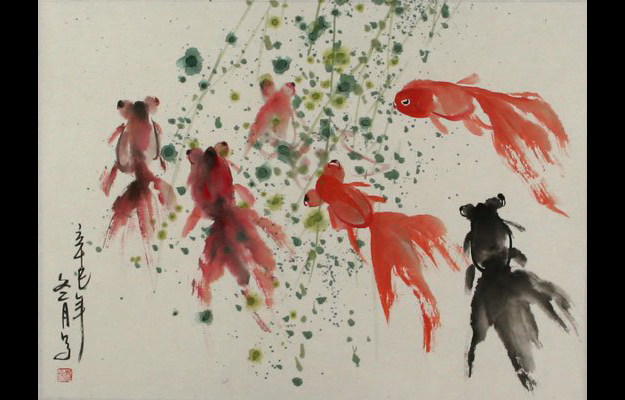
|
||
|
The Frog and the Fish
The warty frog and the prize goldfish met one summer afternoon in the temple pool. "Don't you realize how beautiful I am?" bubbled the goldfish flashing her wispy tail. The frog made no reply. "I can understand your silence," gloated the goldfish. "I am not only graceful in my movements but I also enhance the golden rays of the sun." Again, neither answer or movements from the frog. "Say something," demanded the goldfish just as a waiting crane speared the sparkling fish and flew into the sky. "Bye bye," croaked the frog. ~excerpt and image from: http://www.thedailyzen.org/2015/03/31/the-frog-and-the-fish/?utm_content=buffer8025e&utm_medium=social&utm_source=facebook.com&utm_campaign=buffer Send this link to anyone you think would be interested in reading this entry. |
|
|
|
home |
photography |
3d art |
technology |
diverse |
archive |
comments |
dmdart.com |
zebis.com |
sitemap |
contact me by e-mail
|
| © 2014-2015 dmdart.com/blog : a very small division of Zebis, Inc. - All rights reserved. |